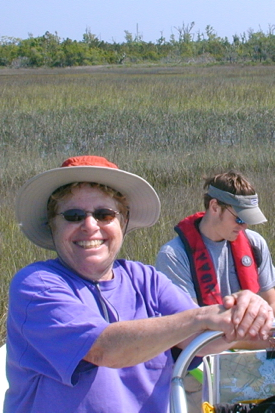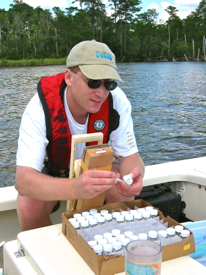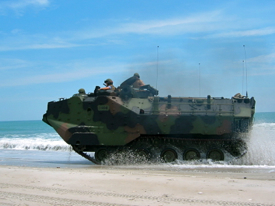VIMS team among honorees for DOD “Project of the Year” award
Professors Iris Anderson and Mark Brush of the Virginia Institute of Marine Science are part of a team that has received one of six “Project of the Year” awards from the U.S. Department of Defense for its contributions to a long-term effort to conserve and protect the natural resources of Marine Corps Base Camp Lejeune in North Carolina.
The Department of Defense’s Strategic Environmental Research and Development Program describes the project—honored in the Resource Conservation and Climate Change category—as “an unprecedented, multi-year interdisciplinary ecological research program” that “is helping DoD manage its coastal installations in more effective and sustainable ways.”
The award-winning project, led by Dr. Patricia Cunningham of RTI International, is known as the Defense Coastal/Estuarine Research Program, or DCERP.
 Anderson, who co-leads the
project’s Aquatic/Estuarine component, says the goal of DCERP is “to develop
ecosystem-based management tools that will allow the military to continue to
use Camp Lejeune for training for decades to come, and to sustain the health of
the New River estuary along which the base sits.”
Anderson, who co-leads the
project’s Aquatic/Estuarine component, says the goal of DCERP is “to develop
ecosystem-based management tools that will allow the military to continue to
use Camp Lejeune for training for decades to come, and to sustain the health of
the New River estuary along which the base sits.”
Base personnel will use the management tools to sustainably manage the area’s coastal ecosystem in the face of increasing temperatures, storminess, sea-level rise, and nutrient pollution, thus providing continued access for training while also fulfilling the military’s adherence to the Clean Water Act.
The 243 square-mile base includes the New River estuary, undeveloped barrier islands, upland forests, and coastal marshes, along with dozens of tactical landing zones, more than 30 gun positions, 80 live-fire ranges, and about 11 miles of beaches that are used to support amphibious operations.
Fieldwork and modeling
Research by Anderson, Brush, and several of their technicians and graduate students uses state-of-the-art measurement and modeling techniques to determine the source and fate of nitrogen, carbon, and other nutrients within Camp Lejeune’s coastal ecosystem, and to investigate how nutrient enrichment affects water quality and food webs in the New River estuary.

The VIMS researchers collaborate on the project with private companies including RTI, Atmospheric Research and Analysis, and Porter Scientific; colleagues at 7 universities in Connecticut, North and South Carolina, and Virginia; and scientists in 3 federal agencies.
The team gathers data both from the New River watershed—land cover, land use, and stream flow, for instance—and from the water, including water clarity, levels of chlorophyll and dissolved oxygen, and concentrations of nitrogen and phosphorous. Brush and colleagues help collect the data, then feed them into computer models to help quantify and predict the source and impact of the nutrients.
“Watershed modeling is an important tool for quantifying the inputs of fresh water, sediments, and nutrients into the estuary,” says Brush, “They help us predict how the estuary will respond to potential changes in these inputs from shifts in land use and climate.”
A resilient yet vulnerable estuary
Anderson says the project’s main finding to date “is that activities on the base have very little impact on water quality. The major source of nutrients is from agricultural operations upstream in the New River watershed.”
She notes that water quality in the New River estuary is still relatively good despite these inputs, likely because the estuary’s shallow waters provide resiliency by encouraging the growth of marine microbes that can remove nutrients from the system.
“More than half the estuary is less than 6-feet deep,” says Anderson. “That allows the benthos to play an important role in mitigating the effects of nutrient enrichment, because light can reach the bottom to fuel photosynthesis and increase the uptake of nitrogen and phosphorous by microbes and the larger animals that feed on them. It’s what we call the benthic filter.”
The research team cautions, however, that the health of the New River estuary is vulnerable to the increased storm run-off and water temperatures that climate models predict for the mid-Atlantic region, while Camp Lejeune’s barrier islands and dunes are threatened by rising seas.
“The efficiency of the benthic filter is greatly susceptible to storm activity and increased stream flow,” says Anderson. “More freshwater input reduces light availability to the bottom, because streams in this area have a lot of what we call CDOM—colored, dissolved organic matter—that’s what makes the water tea-colored. We’re concerned that the estuary’s vulnerability to nutrient enrichment will increase in the future, as storm activity increases due to climate change.”
 In recognizing the DCERP
team with its “Project of the Year” award, the DoD notes “All parts of the base
ecosystem are connected, affecting each other in myriad ways. In turn,
environmental changes can affect training over the long term. DCERP serves as a
model for ecological research management by bringing together participants from
multiple institutions and disciplines to work for several years at the
landscape scale and to ensure the research is linked to practical management
questions at coastal installations. Training at Camp Lejeune can happen only if
its unique beach, sand dune, and marsh features can be sustained year after
year.”
In recognizing the DCERP
team with its “Project of the Year” award, the DoD notes “All parts of the base
ecosystem are connected, affecting each other in myriad ways. In turn,
environmental changes can affect training over the long term. DCERP serves as a
model for ecological research management by bringing together participants from
multiple institutions and disciplines to work for several years at the
landscape scale and to ensure the research is linked to practical management
questions at coastal installations. Training at Camp Lejeune can happen only if
its unique beach, sand dune, and marsh features can be sustained year after
year.”
Anderson, Brush, and their colleagues were recently part of a new contract—again led by RTI International—that extends DCERP by 5 years. The new project focuses on carbon cycling and how climate change will affect the base, with a goal of providing ecosystem models for use as decision-support tools.
Other honorees
Winners of the five other DoD "Project of the Year" awards are:
Environmental Restoration, SERDP Project of the Year
Metric Identification and Protocol Development
for Characterizing DNAPL Source Zone Architecture and Associated Plume Response
Linda
M. Abriola, Eric L. Miller, Kurt D. Pennell, and C. Andrew Ramsburg, Tufts
University; John A. Christ, U.S. Air Force Academy
Project Highlights
Munitions Response, SERDP Project of the Year
Analysis of Next Generation Sensor Data
Dean Keiswetter and Jonathan Miller, SAIC
Project Highlights
Weapons Systems and Platforms, SERDP Project of the Year
Corrosion Protection Mechanisms of Rare-Earth Compounds Based on Cerium and Praseodymium
Bill Fahrenholtz and Matt O’Keefe, Missouri University of Science and Technology
; Eric Morris, Deft,
Inc.
Project Highlights
ESTCP Project of the Year
Modified Biopolymers as an Alternative to Petroleum-Based Polymers for Soil Modification
Steven Larson, U.S. Army Engineer Research and Development Center—Environmental Laboratory;
J. Kent Newman, U.S. Army Engineer Research and Development Center—Geotechnical and Structures Laboratory;
Gregory O'Connor, U.S. Army, PM-Joint Services
; Gary Nijak, Jr., ETS Partners
Project Highlights
ESTCP Project of the Year
Supersonic Particle Deposition for Repair of
Magnesium Aircraft Components
Victor K. Champagne, Jr., U.S. Army Research Laboratory
Project
Highlights




